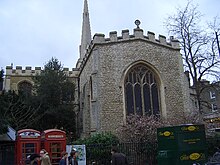
Elias George Basevi FRS was a British architect who worked in both Neoclassical and Gothic Revival styles. A pupil of Sir John Soane, his designs included Belgrave Square in London, and the Fitzwilliam Museum in Cambridge. He was surveyor to the Guardian Assurance Company, to the Trustees of Smith's Charity and to the Thurloe estate.
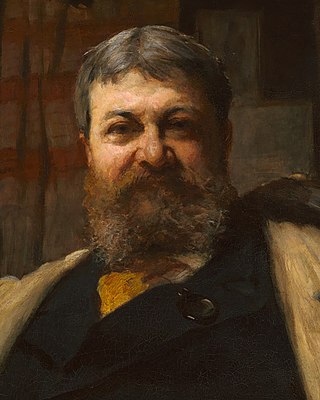
Henry Hobson Richardson, FAIA was an American architect, best known for his work in a style that became known as Richardsonian Romanesque. Along with Louis Sullivan and Frank Lloyd Wright, Richardson is one of "the recognized trinity of American architecture."

Sir Arthur William Blomfield was an English architect. He became president of the Architectural Association in 1861; a Fellow of the Royal Institute of British Architects in 1867 and vice-president of the RIBA in 1886. He was educated at Trinity College, Cambridge, where he studied Architecture.

The Ascension Parish Burial Ground, formerly known as the burial ground for the parish of St Giles and St Peter's, is a cemetery off Huntingdon Road in Cambridge, England. Many notable University of Cambridge academics are buried there, including three Nobel Prize winners.
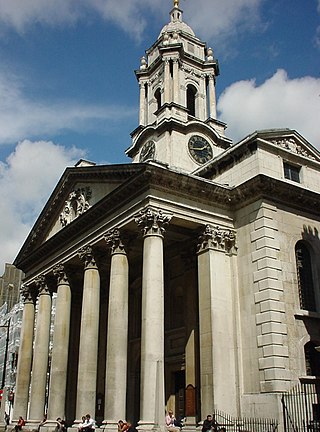
St George's, Hanover Square, is an Anglican church, the parish church of Mayfair in the City of Westminster, central London, built in the early eighteenth century as part of a project to build fifty new churches around London. The church was designed by John James; its site was donated by General William Steuart, who laid the first stone in 1721. The building is one small block south of Hanover Square, near Oxford Circus. Because of its location, it has frequently been the venue for society weddings.

Hobson's Conduit, also called Hobson's Brook, is a watercourse that was built from 1610 to 1614 by Thomas Hobson and others to bring fresh water into the city of Cambridge, England from springs at Nine Wells, a Local Nature Reserve, near the village of Great Shelford. It is now a Scheduled Ancient Monument and historical relic. The watercourse currently runs overground until Cambridge University Botanic Garden and Brookside, where it is at its widest. At the corner of Lensfield Road stands a hexagonal monument to Hobson, which once formed part of the market square fountain, and was moved to this location in 1856, after a fire in the Market. The flow of water runs under Lensfield Road, and subsequently runs along both sides of Trumpington Street in broad gutters towards Peterhouse and St Catharine's College, and also St Andrew's Street. The conduit currently ends at Silver Street.

The architecture of Aylesbury, the county town of Buckinghamshire, reflects that which can be found in many small towns in England. The architecture contained in many of the country's great cities is well recorded and documented, as is that of the numerous great country houses. Frequently, the work is by one of England's more notable architects – Christopher Wren, John Vanbrugh, Robert Adam, William Kent or even Quinlan Terry. What is less well known is the local architecture in the market towns, often inspired by the work of the great master architects or architectural styles popular at the time. English merchants would often return from a visit to one of the nearby cities, or having seen a glimpse of one of the great country houses then require a replica of what they had seen. A local architect would then be employed to recreate it, within limited financial restraints. Sometimes the patron would merely draw an image of what he required and a builder would then interpret the requirements to the best of his often limited ability.
Henry Isaac Stevens FRIBA was an architect based in Derby. He was born in London, in 1806, and died in 1873. In the late 1850s he changed his name to Isaac Henry Stevens.

Jesus Lane is a street in central Cambridge, England. The street links with the junction of Bridge Street and Sidney Street to the west. To the east is a roundabout. To the south is King Street, running parallel with Jesus Lane and linking at the roundabout. The road continues east as Maid's Causeway and then Newmarket Road east out of Cambridge. To the north is Victoria Avenue between Jesus Green to the west and Midsummer Common to the east. Also to the north near the western end is Park Street, location of the ADC Theatre. To the south is Short Street, quickly leading into Emmanuel Road past Christ's Pieces.

Sidney Street is a major street in central Cambridge, England. It runs between Bridge Street at the junction with Jesus Lane to the northwest and St Andrew's Street at the junction with Hobson Street to the southeast.
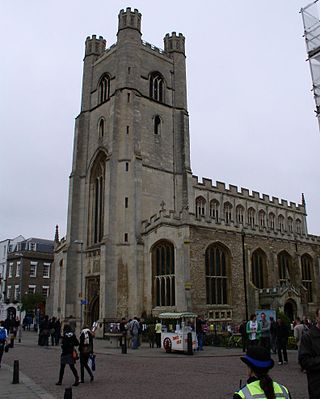
St Mary's Street is a historic street in the centre of the University area in Cambridge, England. The street links with the junction of King's Parade and Trinity Street to the west, along which many of the University's oldest colleges are to be found. To the east is Market Hill, the location of the city's Market Square. The street continues as Market Street.

St Andrew's Street is a major street in central Cambridge, England. It runs between Sidney Street, at the junction with Hobson Street, to the northwest and Regent Street to the southeast. Downing Street leads off to the west.

Market Hill is the location of the marketplace in central Cambridge, England. Operating as a marketplace since Saxon times, a daily outdoor market with stalls continues to run there.

Holy Trinity Church is a church in Market Street, in the city of Cambridge, in Cambridgeshire,England, on the corner with Sidney Street. Its current vicar is Stuart Browning. Theologically, it stands within the charismatic evangelical tradition of the Church of England.
David Wyn Roberts was a British architect and educator, who designed more university buildings for Cambridge University than any other architect. With a modernist practice based in Cambridge, he also designed many city housing projects, schools, and private residences.

Holy Trinity Rectory is a heritage-listed Anglican clergy house at 141 Brookes Street, Fortitude Valley, City of Brisbane, Queensland, Australia. It was designed by Francis Drummond Greville Stanley and built in 1889 by James Robinson. It was added to the Queensland Heritage Register on 21 October 1992.

Holy Trinity Church is a heritage-listed Anglican church at 39 Gordon Street, Mackay, Mackay Region, Queensland, Australia. It was designed in 1923 by Lange Leopold Powell and built by A Stonage and Sons, completing in 1926. It is also known as Holy Trinity Church Complex. It was added to the Queensland Heritage Register on 29 April 2003.
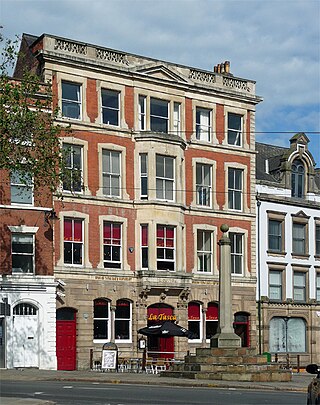
William Arthur Heazell FRIBA was an architect based in Nottingham.

The Cambridge Centre for Christianity Worldwide (CCCW) is a study, teaching and research centre in Cambridge, England and a member of the Cambridge Theological Federation which is affiliated with the University of Cambridge.
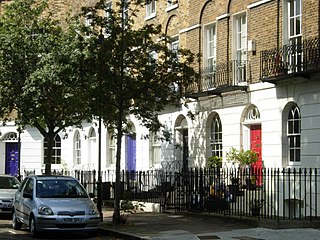
Cloudesley Square is a square in the Barnsbury district of Islington, North London. It is bounded by Georgian terraced houses, all of which are listed buildings. The central area is occupied by the Gothic Revival former Holy Trinity Church, designed by Charles Barry.

